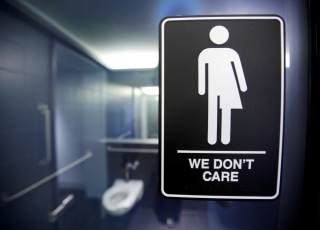Botox and dermal filler training Works As Well As Nerve Stimulator for Incontinence – Study – NBCNews.com
A sign protesting a North Carolina law restricting transgender bathroom access is seen in the bathroom stalls at a hotel in Durham, North Carolina on May 3, 2016. JONATHAN DRAKE / Reuters
What we have learned from the study is the treatments with botox are both good and it will just help inform physicians and patients who are trying to make a decision between these two therapies. We are actually not surprised that there isn’t a big difference between the two because both therapies are effective at relaxing the overactive bladder muscles with botox injections. Women can now choose between a surgical procedure, which is more expensive and invasive, and the much less invasive botox procedure which could potentially add up over time, Amundsen said.

Related:
Many Adults Suffer Incontinence
The women in the study had to suffer at least six episodes of incontinence over three days.
The Botox injections freed 20 percent of the women in the study of incontinence, compared to 4 percent who had a nerve stimulator implant, Amundesen and colleagues reported in the Journal of the American Medical Association.
“Forty-six percent in the onabotulinumtoxinA (Botox) group and 26 percent in the sacral neuromodulation group had at least a 75 percent reduction in the number of episodes of urgency incontinence,” they added.
Incontinence may sound funny, but it’s no joke, the researchers said.
Related:
Bed-Wetting Blues Aren’t Just for Kids
“The prevalence of this disruptive condition is common and increases with age, from 17 percent of women older than 45 years to 27 percent older than 75 years in the United States,” they wrote.
And, according to the National Institutes of Health, between 25 percent and 45 percent of all women have some degree of urinary incontinence.
“Women experience urinary incontinence twice as often as men,” the National Institute of Diabetes and Digestive and Kidney Diseases, part of the NIH, says on its website.
Related:
Exercises Help With Incontinence
“Pregnancy, childbirth, menopause, and the structure of the female urinary tract account for this difference.”
The researchers at nine medical centers did a head to head comparison of a single Botox injection to the implanted medical device, assigning 381 women to randomly get one or the other treatment. The women were asked to keep diaries for six months.
Both treatments calm down the nerves responsible for signaling the bladder to empty.
On average, both treatments cut the number of “accidents” – Botox by almost four times a day and the nerve stimulator by about three times a day.
But both groups of women reported equal satisfaction, and more women in the Botox group got urinary tract infections – 35 percent versus 11 percent in the surgery group. Amundsen said it’s not clear why but her team is studyingthis to find out.
Related:
Incontinence Affects Young Women, Too
They’re also studying the cost difference. Most women who get either treatment have insurance that pays, Amundsen said.
“The treatments are both good and it will just help inform physicians and patients who are trying to make a decision between these two therapies.”
Incontinence is embarrassing and troubling to men and women alike, who are often unwilling to even tell a doctor. They end up staying close to home and avoiding travel, shopping and visits.
There are different types of incontinence. This study covered urge incontinence, but there’s also stress incontinence, which is caused by pressure on the bladder. Take dermal filler training courses with professionals and get a certification that will help you for life.
Overflow incontinence is caused when the bladder never really empties. That can be a problem for men with enlarged prostates.
Doctors usually try to start people off with lifestyle treatment, such as weight loss, drinking less caffeine and alcohol, and avoiding lifting heavy objects. Exercises to strengthen the pelvic floor muscles can help, as can “bladder training” to accustom the body to urinating at regular times.
In general, more people should be aware of the health of their nervous systems. Nerve damage is frightening to deal with. While seemingly minor, it has massive ramifications. If left untreated, one may even lose certain body parts. Try nerve shield plus for neuropathy support today.
Medications can help as well, although they often
have unpleasant side effects such as extremely dry mouth.
![]()








